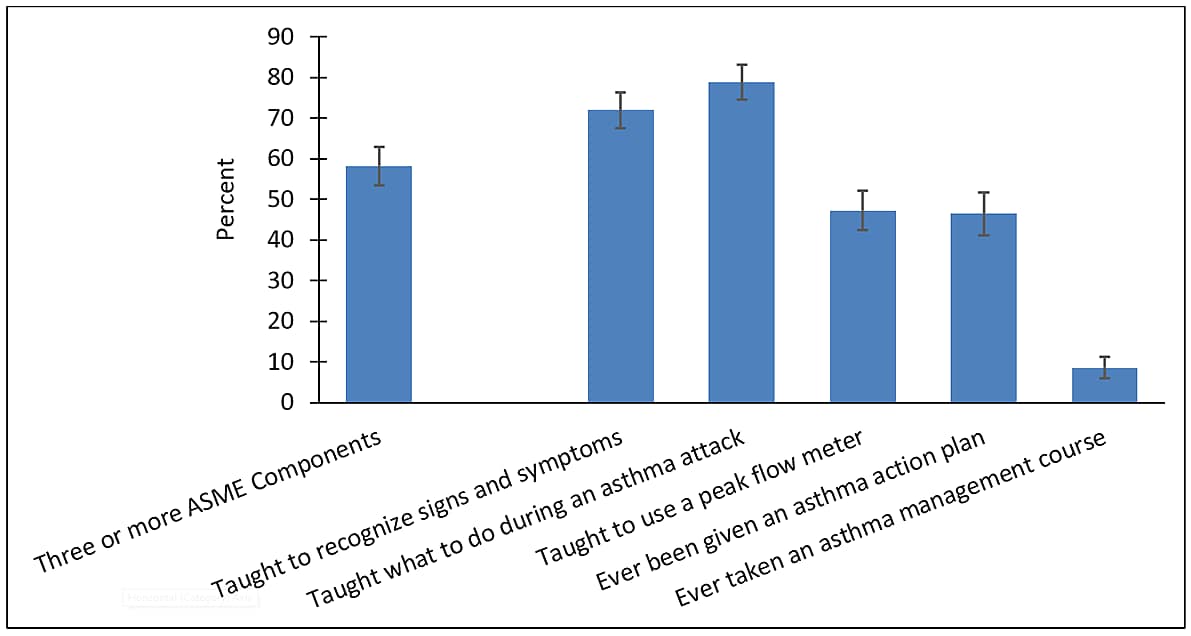Asthma Self-Management Education Among Children With Current Asthma – United States, 2018
More than half (58.3%) of children with asthma received three or more asthma self-management education components.
Figure 1. Percentage of asthma self-management education components among children with current asthma — United States, 2018

Abbreviation: ASME, asthma self-management components
More than half (58.3%) of children with asthma received three or more asthma self-management education (ASME) components.* The most commonly reported ASME component was “taught what to do during an asthma attack” (78.8%), followed by “taught to recognize signs and symptoms” (72.0%), “taught to use a peak flow meter” (47.3%), “ever been given an asthma action plan” (46.5%), and “ever taken an asthma management course” (8.6%) (Figure 1 and Table).
Although reported ASME did not differ by sex, it differed by age and race/ethnicity:
- Asthma education was higher among age group 0–4 years than age group 12–17 years (by proxy) (Table).
- The percentage of those who reported “taught to use a peak flow meter” was higher among Black non-Hispanic (NH) children than among White NH children (Table).
Figure 2. Percentage of children with current asthma who had three or more asthma self-management education components by selected characteristics — United States, 2018

Abbreviation: NH, non-Hispanic
CDC’s National Asthma Control Program (NACP) was created in 1999 to help the millions of people with asthma in the United States gain control over their disease. The NACP conducts national asthma surveillance and funds states to help them improve their asthma surveillance and to focus efforts and resources where they are needed.
| Asthma self-management education* | ||||||
|---|---|---|---|---|---|---|
| Taught to recognize signs and symptoms | Taught what to do during an asthma attack | Taught to use a peak flow meter | Ever been given an asthma action plan | Ever taken an asthma management course | Three or more asthma self-management education components | |
| Characteristic | % (CI) | % (CI) | % (CI) | % (CI) | % (CI) | % (CI) |
| Total | 72.0 (67.4-76.1) |
78.8 (74.2–82.7) |
47.3 (42.4–52.3) |
46.5 (41.3–51.9) |
8.6 (6.3–11.5) |
58.3 (53.4–63.0) |
| Sex | ||||||
| Male | 72.7 (66.4–78.2) |
79.9 (73.8–84.8) |
47.6 (40.8–54.5) |
50.2 (43.4–57.0) |
8.6 (5.8–12.5) |
58.5 (51.8–64.9) |
| Female | 71.0 (63.6–77.5) |
77.3 (69.8–83.4) |
46.9 (39.2–54.8) |
41.8 (34.3–49.8) |
8.5 (5.2–13.6) |
58.0 (50.6–65.0) |
| Age (year) | ||||||
| 0–4 | 83.5 (71.5–91.1) |
92.8 (82.6–97.2) |
61.1 (47.6–73.0) |
62.2 (48.6–74.1) |
10.4† (4.3–23.3) |
74.1 (60.6–84.2) |
| 5–11 | 73.6 (66.3–79.8) |
79.9 (72.8–85.4) |
45.6 (37.9–53.6) |
47.0 (39.2–54.9) |
7.5 (4.4–12.3) |
58.8 (50.8–66.4) |
| 12–17 | 66.8 (59.2–73.6) |
73.4 (65.7–79.8) |
44.6 (37.1–52.3) |
41.2 (33.9–48.9) |
9.1 (6.1–13.3) |
53.0 (45.6–60.2) |
| Race and Ethnicity | ||||||
| White NH | 70.9 (64.5–76.5) |
79.2 (73.2–84.1) |
39.9 (33.3–47.0) |
45.9 (38.9–53.0) |
5.9 (3.4–9.9) |
56.5 (49.4–63.2) |
| Black NH | 75.1 (63.2–84.1) |
80.9 (69.0–89.0) |
59.0 (47.4–69.7) |
54.7 (42.6–66.3) |
10.1 (5.7–17.3) |
68.3 (56.8–77.9) |
| Hispanic | 68.8 (57.7–78.0) |
73.7 (62.5–82.5) |
49.9 (38.8–61.1) |
40.8 (30.9–51.5) |
12.6 (7.4–20.5) |
56.1 (45.1–66.6) |
| Other NH | 76.6 (64.8–85.4) |
85.2 (75.2–91.7) |
40.0 (27.8–53.6) |
44.1 (30.8–58.3) |
4.3† (1.6–10.9) |
46.4 (33.4–59.8) |
Abbreviations: NH, non-Hispanic; CI, 95% confidence interval.
* Reported by adult proxy
† Relative standard error of the estimate is is ≥30%; the estimate is unreliable
Source: 2018 National Health Interview Survey (NHIS)